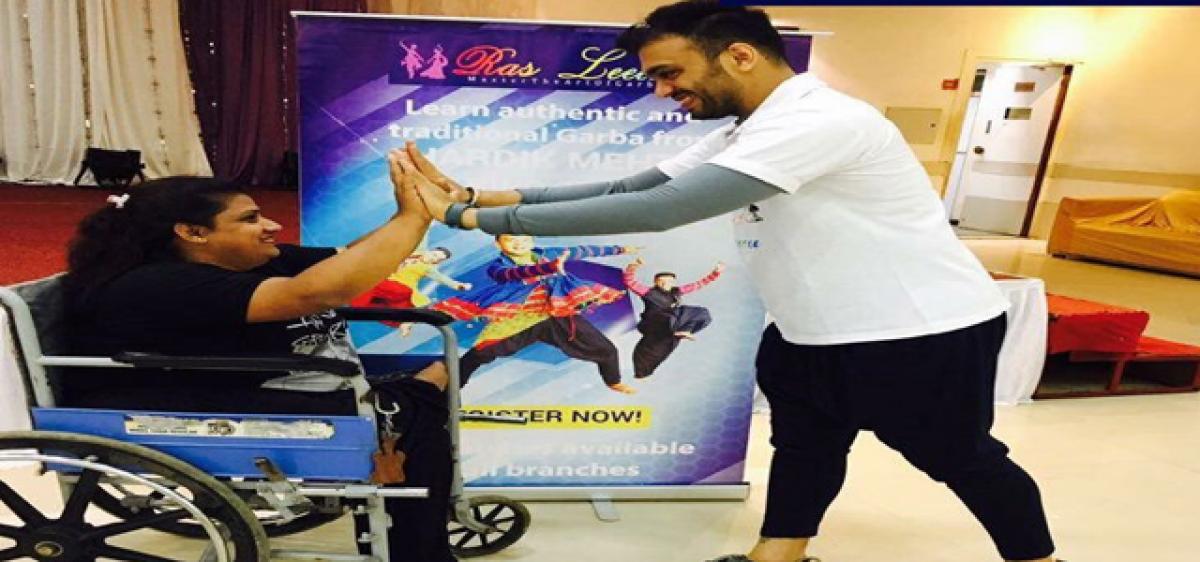Live
- Pink Power Run for awareness on breast cancer held in Hyderabad, CM Revanth Reddy attends
- Students exhorted to work hard to scale heights
- Officials told to submit proposals for Guntur channel extension
- KIMS Ongole organises 3K walk
- Gold rates in Visakhapatnam slashes today, check the rates on 29 September, 2024
- Gold rates in Vijayawada slashes today, check the rates on 29 September, 2024
- AI and the future of immersive experiences: Bridging tangible and intangible heritage
- Budameru flood victims eagerly wait for compensation
- Discovering Self Love
- MyVoice: Views of our readers 29th September 2024
Just In

Mumbai, with a Gujarati population of around five million, is one of the hotbeds for navratri celebrations after Gujarat. This year, at several suburban Navratri venues, the major attraction is a young man and a woman as they play dandiya on wheelchairs.
Mumbai, with a Gujarati population of around five million, is one of the hotbeds for navratri celebrations after Gujarat. This year, at several suburban Navratri venues, the major attraction is a young man and a woman as they play dandiya on wheelchairs.
The duo occupies centre-stage at venues teeming with several thousands of dancers, and seated in their wheelchairs, they swing to the lilting tunes and musical beats -- but with hand movements (garba) and later with dandiyas (sticks).
There is also a hearing impaired girl who can barely hear the cacophony around her, but she quietly "follows" the dance-steps of the individual before her and virtually melts into the crowds.
The trio belong to 'Rasleela - Master the Art of Garba' dance troupe run by hotelier-cum-choreographer Hardik Mehta in the Kandivali suburb,.
Siddhi Shah, 30, working as a senior executive in a private company, Dhaval Shah, 26, working as a realtor -- both wheelchair-bound -- and hearing-disabled Jesal Shah, 30, an interior designer live in the suburbs.
To enable Siddhi and Dhaval make the best of the opportunity, Mehta and his team of teachers designed special "hand movements" -- instead of normal dancing steps -- which could be performed sitting in their wheelchair. It clicked with the duo.
They managed to pick it up so well that they now confidently travel with a 45-member Rasleela troupe to various top navratri venues during the ongoing season.
Afflicted by polio in her childhood, Siddhi always yearned to learn garba and dandiya, but the doors were slammed everywhere on her face -- till she met Mehta. "I now feel I belong to the huge navratri family; I have learnt a lot of easy and difficult hand movements.
It was tough, but there cannot be excuses for anything," says Siddhi, who is also an avid traveller, having roamed around a large part of India on her wheelchair.
Suffering from a spinal condition which left him disabled, Dhaval was earlier content with going around navratri venues, watching others dance and longing to join them, but did not know how to overcome his challenge. "It was only after joining this class that I felt confident,” he shared.
Jesal's hearing disability was a major dampener for her sheer passion for dancing, especially during navratri, and she joined Mehta's classes in 2015.
"She uses a hearing aid in normal course, but it's of little use in the open grounds... she could easily get out of rhythm or bump into the others dancing around her. I trained her to strictly follow the dance-steps of the person right in front of her. Now, she performs very well," Mehta sounds proud.
By: Quaid Najmi

© 2024 Hyderabad Media House Limited/The Hans India. All rights reserved. Powered by hocalwire.com







